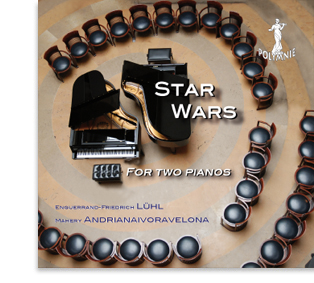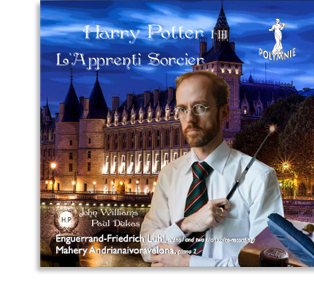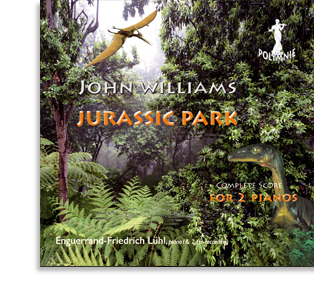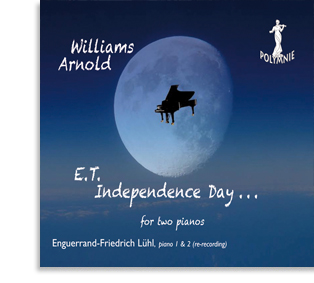 |
|||||

John Williams, Greatest Hits for
piano solo
Enguerrand-Friedrich
Lühl-Dolgorukiy, piano
POL 128 142
John Williams
Jaws (1975)
The Shark’s Theme
Superman (1978)
March
Dracula (1979)
Mina’s Funeral, End Titles
Raiders of the lost Ark (1980)
March from Indiana
Jones
Monsignor (1982)
Main Title
E.T. – the Extraterrestrial (1982)
Flying,
Adventures on Earth, Over the Moon
Indiana Jones and the Temple of Doom (1984) Parade of
the Slave Children
Olympic Fanfare and Theme
1984 Olympic Games, Los
Angeles
The Witches of Eastwick (1987) Devil’s Dance
The Olympic Spirit
Created for the NBC Broadcast of
the 1988 Summer Olympics, Seoul
Indiana Jones & the Last Crusade (1989)
Scherzo
for Motorcycle and orchestra
Hook (1991)
Flight to Neverland
Far and Away (1992)
Suite
Schindler’s List (1993) Main Theme, Jewish Town,
Remembrances
Jurassic Park (1993)
Main theme
Sabrina (1995)
Main Theme
The Lost World (1997)
Main Theme
H. Potter and the Sorcerer’s Stone (2001) Hedwig’s
Theme, Harry’s Wondrous World
Call of the Champions Official Theme of the (2002)
Olympic Winter Games, Salt Lake City
Catch Me if You Can (2002)
Closing in
Harry Potter and the Chamber of Secrets (2003) Fawkes
the Phoenix, The Chamber of Secrets
The Terminal (2004) Viktor’s Tales
Harry Potter and the Prisoner of Azkaban (2004) Aunt
Marge’s Waltz, Hagrid’s friendly Bird
Indiana Jones & the Kingdom of the Crystal Skull
(2008)
Irina’s Theme
John Williams... 40 ans de carrière pour piano
Né en 1932, auteur en outre de quatre hymnes olympiques (Los Angeles, Séoul, Atlanta et Salt Lake City), chargé de la partie musicale de l’investiture de Barack Obama, à présent titulaire de 5 Oscars (49 nominations), de 4 Golden Globes, de 7 BAFTA Awards et de 21 Grammy Awards, ayant été intronisé au Hollywood Bowl Hall of Fame en 2000 et récipiendaire du Kennedy Center Honors en 2004, John Williams est devenu, après Walt Disney, l’artiste cinématographique le plus récompensé de l’histoire du cinéma.
Le travail de Williams
Chaque compositeur a sa propre méthode de
travail. Williams, après l’élaboration sommaire des grandes
ambiances générales du film concerné, dresse un canevas orchestral
pour instrumentarium réduit (10 à 12 instruments) et laisse, faute
de temps pour le faire lui-même, ses orchestrateurs parfaire et
affiner l’œuvre. Il est aujourd’hui l’un des rares compositeurs à
toujours écrire à la main, la majeure partie des compositeurs
utilisant une logistique informatique permettant des changements
d’orchestration de dernière minute pendant les sessions de
répétition ou d’enregistrement avec l’orchestre en synchronisé
avec la projection du film. Une fois la musique intégralement
enregistrée, elle peut subir de sévères coupures dues à
d’éventuels montages postérieurs, ce qui rompt la structure des
enchaînements musicaux. Malheureusement, le plus souvent, ces
coupures abruptes sont faites au profit de l’image et dénaturent
la qualité de la construction musicale.
Une fois la musique pour le film entièrement composée et
enregistrée (en partie rejetée et recomposée à la demande du
réalisateur), Williams crée une suite de concert des meilleurs
moments musicaux du film, rassemblant les principaux thèmes afin
qu'ils soient plus facilement joués en salle individuellement pour
un programme composite. C’est ainsi que nous pouvons trouver les
partitions d’une ‘Children’s suite’ de Harry Potter I,
trois pièces de Schindler’s List, une suite des épisodes I
à IX de Star Wars, une longue pièce symphonique de E.T...
Chaque œuvre est remaniée musicalement, parfois augmentée de
passages inexistants dans le film en réutilisant le même matériau
musical. Les suites de concert sont destinées à être jouées sans
accompagnement cinématographique.
Le travail de Lühl
Ce disque présente John Williams en tant que
compositeur des plus grandes musiques de films d’Hollywood sur une
carrière de plus de quarante ans dans une version pour piano solo.
Comment ce jeune artiste a-t-il réussi à vaincre ce défi
exceptionnel?
Travaillant pour la diffusion des œuvres de Williams
depuis 2006, Lühl a transcrit fidèlement près de 60 titres du
compositeur américain pour piano seul et deux pianos. La première
surprise que l’on découvre grâce à ces transcriptions, dont chaque
note de l’immense appareil orchestral est reprise aux pianos, est
la limpidité des différentes voix qui se retrouvent inondées dans
la masse orchestrale d’origine : le discours devient transparent
et presque évident.
Pour une plus grande ‘vulgarisation’ de ces thèmes qui hantent les
esprits des spectateurs admiratifs, divers arrangeurs publient
normalement - parfois même anonymement - des recueils pour piano
rassemblant normalement les meilleures pages des films illustrés
par Williams. Cependant, ces arrangements, destinés au pianiste
amateur, tronquent considérablement les pièces et les simplifient
à outrance au point qu’on puisse à peine en reconnaître
l’original. Cette bien faible retranscription détruit, par la
réduction à l’état de simplicité musicale extrême, le caractère de
l’œuvre. Une œuvre de neuf minutes pour orchestre peut ainsi se
retrouver compressée sur deux pages pour piano et durer neuf fois
moins, juste pour qu’on puisse se dire que l’on est capable de
jouer le thème de E.T. – l’extraterrestre ! La qualité de ces
arrangements nuit à l’original pour les puristes et de nombreux
pianistes ne rêvent que d’une chose : pouvoir un jour revivre
l’aventure de manière réaliste en marchant dans les pas de l’œuvre
avec un arrangement complet.
C’est ainsi qu’Enguerrand-Friedrich Lühl entreprend son immense
travail d’arrangement des œuvres de John Williams pour piano seul
et deux pianos, désireux de faire connaître au public et au
pianiste avancé la musique de Williams sous un autre angle : le
piano symphonique avec toute la palette sonore que ce magnifique
instrument est capable de déployer. Toute la dimension symphonique
doit être fidèlement exécutée par deux ou quatre mains.
Lühl explore toutes les facettes de son instrument, faisant appel
à des techniques percussives contemporaines rappelant les bongos,
les cymbales, la grosse caisse, la caisse claire, le chimes ou
même la harpe. Rien n’est épargné pour mieux contribuer au
réalisme de l’ambiance à retracer : couvercle, bois frappé, cordes
pincées, troisième pédale ‘tonale’, parties corporelles des
pianistes (ongles, plat de la main, doigts frappés, genoux, le
tout parfois même simultanément à deux pianos pendant le jeu
digital !). L’ensemble entraîne l’auditoire dans un monde
fantastique et imaginaire, et enfin, il pourra entendre les
versions complètes des pièces qui l’ont fait rêver durant sa
jeunesse.
![]()





![]()
Lühl-Dolgorukiy
travaille en collaboration avec les éditions phonographiques
Polymnie pour l’intégrale de l’enregistrement de ses œuvres.
Sont déjà disponibles ses quatre premiers Quatuors à cordes (POL
480 243 et POL 480 364), le
Requiem Vauban (POL 790 344), sa
cinquième Symphonie sous sa direction (POL
990 361) et de nombreux CD Rachmaninoff, dont le deuxième
Concerto pour piano op. 18 et la Rhapsodie sur un thème de
Paganini dans une réduction pour deux pianos de l’auteur (POL
150 865). Notons aussi un travail considérable
avec l'édition des oeuvres de John Williams Star Wars (POL
151 686), Harry Potter (POL
105 109), Jurassic Park (POL 108
115)... d’autres albums sont en préparation.
Lühl's recordings are available at the music label
Polymnie, for which he already recorded several works of his
own, conducting an orchestra for his Fifth Symphony (POL
990 361), or playing the piano, and more recently a CD of
piano pieces by S. Rachmaninoff and the Rhapsody on a theme by
Paganini as well as the Second piano concerto op. 18 (POL
150 865), also several CD by John Williams, Star Wars (POL
151 686), Harry Potter (POL
105 109), Jurassic Park (POL 108
115)... Lühl is planning to record his entire work (about
50 CDs).
![]()
Greatest hits
for piano solo
Born in 1932, besides being
the author of four Olympic hymns (Los Angeles, Seoul, Atlanta
and Salt Lake City), American Hollywood composer John Williams
now owns 5 Oscars (he was nominated 49 times !), 4 Golden
Globes, 7 BAFTA Awards and 21 Grammy Awards. In 2000 he entered
the Hollywood Bowl Hall of Fame and received the Kennedy Center
Honors in 2004, John Williams which makes him the most awarded
individual in the history of the motion picture since Walt
Disney.
Williams’ work
Every composer has his own
method of working. Williams, after composing his themes and main
musical atmospheres of the movie at the piano, writes down a
particell for small orchestra (10 to 12 instruments) and leaves
the final orchestration, because of lack of time, to his
orchestrators. Today, he is one of Hollywood’s rare composers
who still writes by hand and not use increasingly complex
software like most of his contemporaries. Then, the editor
prints the separate parts for each instrument of the orchestra
and last minute changes occur during rehearsals or the recording
sessions while synchronizing with the organic motion of the
film. Once the music is completely recorded, it is often cruelly
cut for future video editing which breaks the musical structure.
Unfortunately, such cuts, made to enhance the plot, tend to
damage the quality of the musical integrity behind the image
flow. Once the musical composition for the film is completed and
entirely recorded (some parts being rejected or sometimes even
recomposed according to the director’s instructions), Williams
creates a concert suite of the best musical moments of the film,
consisting of a thematic medley to be performed on stage during
a film music concert.
For example, his editor has published the score of a Children’s
Suite from Harry Potter I, three pieces from Schindler’s List, a
concert suite from the Star Wars saga and a long symphonic piece
from E.T. – the extraterrestrial, featuring music which doesn’t
appear in the films. Each piece has therefore been musically
revised, sometimes by adding new musical sequences and reusing
similar musical material. These concert suites are generally
designed for a concert performance of film music.
This CD presents composer John Williams as the most distinguished musical talent in Hollywood over a more than forty-year old career. How did this young multi-talent artist manage to master this exceptional challenge? To reach a broader audience for these themes haunting the minds of admiring viewers, many composers usually arrange – sometimes even anonymously – pieces for piano assembling the best parts of films musically illustrated by their respective composers. However, these arrangements, conceived for amateur pianists, sever the pieces dramatically and simplify them to the point that one barely recognizes the original score. This horribly weak adaptation destroys the work’s genuine character and reduces it to the slight minimum – the main theme and a primitive accompaniment! A work of nine minutes for orchestra is accordingly compressed into a one-minute pieces of two piano pages – just for the pleasure of the amateur performed calming that he is capable of playing the 'ET theme'. The quality of such scores does not do credit to the original purists and fans and many more serious pianists can only dream of one thing: relive the musical journey in a more realistic and demanding way by playing more of the original work than only a few reductive pages.
For this reason, Lühl started his tremendous work by enthusiastically adapting orchestral pieces by John Williams for piano solo and two pianos in a desire to make the public aware of John Williams’ musical quality from another angle: the symphonic piano with all its variety of organic sounds! Lühl therefore decided to explore all the aspects of the instrument, using the piano as a contemporary tool which would recall the effects produced within the orchestra: bongos, cymbals, bass drum, chimes, harps, etc. Everything contributes to the atmosphere’s realism by e.g. hitting the piano lid and creating wooden sounds, pinching strings, using other body parts than only the fingers (nails, palms of the hands, knees, even at the same time during the performance). Finally, Lühl will be able to hear both new and authentic versions of the pieces he dreamt about in his childhood.
![]()
Accueil | Catalogue
| Interprètes | Instruments
| Compositeurs | CDpac
| Stages | Contact
| Liens
• www.polymnie.net
Site officiel du Label Polymnie • © CDpac • Tous droits
réservés •



